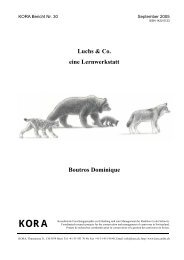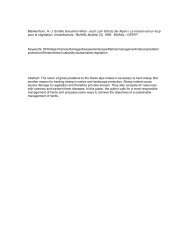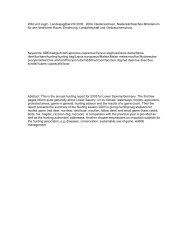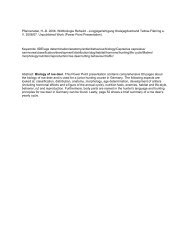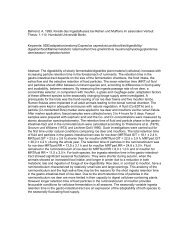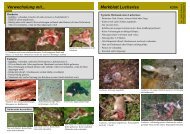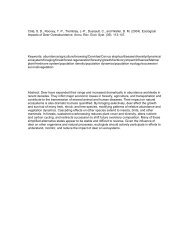26 Appendix IKORA <strong>Bericht</strong> Nr. 13simply mimic the pattern of the surrounding sceneryand secondly, stripes may run across the natural contoursof the animal `s body, and being visually strongfeatures, disrupt the characteristic outline of the animal(Godfrey et al. 1987).Concealing coloration can also be divided into protectiveresemblance and aggressive resemblance, respectivelyreflecting the need to be concealed frompredators and the need to approach prey undetected.Intuitively, aggressive background resemblance mightbe expected to be more prevalent in carnivores, butmany species in this order are themselves subject topredation (Ortolani & Caro 1996). Although genescontrol the processes involved in coat pattern formation,the actual mechanisms that create the patterns arestill unknown. It would be attractive from the viewpointof both evolutionary and developmental biologyif a single mechanism would be found to produce theenormous assortment of coat patterns found in nature(Murray 1988).Murray’s (1988) mathematical model describes howthese patterns may be generated in the course of embryonicdevelopment. An important feature of themodel is that the patterns it generates bear a strikingresemblance to the patterns found on a wide variety ofanimals such as the leopard, cheetah, jaguar, zebra andgiraffe. The model predicts that the patterns can takeonly certain forms, which in turn implies the existenceof developmental constrains and begins to suggest howcoat patterns may have evolved. Physically, spots correspondto regions of differently colored hair. Haircolor is determined by specialized pigment cells calledmelanocytes, which are found in the basal, or innermost,layer of the epidermis. The melanocytes generatea pigment called melanin that then passes into the hair.In mammals there are essentially only two kinds ofmelanin: eumelanin, from the Greek words eu (good)and melas (black), which results in black or brownhairs, and phaeomelanin, from phaeos (dusty), whichmakes hairs yellow or reddish orange.Turing (1952) postulated a chemical mechanism forgenerating coat patterns. He suggested that biologicalform follows a prepattern in the concentration ofchemicals he called morphogens, which can react withone other and diffuse through cells. Spatial patterns ofmorphogen concentrations can arise from an initial uniformdistribution in an assemblage of cells. In reactiondiffusionmodels one starts with two morphogens thatcan react with each other and diffuse at varying rates.If the morphogens are now allowed to diffuse at equalrates, any spatial variation from that steady state still besmoothed out. If the diffusion rates are not equal, diffusioncan be destabilizing: the reaction rates at anygiven point may not be able to adjust quickly enough toreach equilibrium. If the conditions are right, a smallspatial disturbance can become unstable and a patternbegins to grow. The type of pattern that results dependson the various parameters of the model and can be ob-tained from mathematical analysis. Closely related speciescan exhibit similar color markings and behavioralecology as a result of shared ancestry. In spite of thisfact, by simply testing the correlation between colorationvariables and behavioral-ecological variables, adaptationscould not be distinguished from homologies(Ortolani & Caro 1996).2.3. Systematics and biogeographyFelids have engendered considerable systematic controversy.The cause of the problem is: small samples,lack of information, ambiguous original descriptions,and authors ignoring earlier publications. Different genericclassifications resulting from the study of a varietyof characters (e.g., morphological, morphometrical,behavioral, biochemical, and cytogenetic) have resultedin the recognition of 4 to 9 genera. The tendencyduring recent years to group many felid species intolarge cosmopolitan genera (e.g., Ellermann and Morrison-Scott,1966) has simplified the nomenclature, butthese assemblages are not supported by original data(Garcia-Perea 1994). In the study with the pampas cat,Felis colocolo, Garcia-Perea (1994) found some unusualpatterns of variation within the population identifiedas colocolo while conducting a phylogenetic studyon the living species of felids. An examination of allavailable museum specimens revealed that this assemblageconsisted of three closely related species. Theirdiagnostic characters and geographic distribution hasbeen the subject of that study. 86 specimens of Pampascats have been examined, consisting of 72 skins and 51skulls, from eight large North American, South American,and European collections. The evaluation of morphologicalvariation included descriptions of pelagevariations, which emphasized the characteristics anddistribution of the markings. Spotting patterns are importantin felid systematics. Closely related cats sometimesshow similar patterns, which has been misinterpreted(e.g., Lynx lynx has been confused with Lynxpardinus in the Carpathian and Caucasus Mts.). Coloris also important, but is unreliable in old skins becauseof fading. Garcia-Perea (1994) recognized five unitsfor the morphological analysis. Each represent an apparentlycontinuous population.Felids show great variation of coat patterns. Similaritybetween species has often been used to indicatephylogenetic relationships, and variation within speciesas taxonomic criteria for subspecific differentiation.The study of the distribution and characteristics of pelagemarkings revealed a significant amount of variation,which partially explains the large number of taxadescribed for this group. Garcia-Perea distinguishedeight parts of color and pattern variation for the parts ofthe head, body, and tail (face, ears, spinal crest, throat,chest and abdomen, tail, legs and feet). The descriptionof basic spotting types showed three general patterns(types 1, 2, and 3). The different coat pattern types aredistributed geographically.
Juni 2002 Appendix I27With felids, it is often difficult to find morphologicalcharacters that are completely diagnostic, especiallyin closely related species, because atypical characterstated commonly appear at low frequency. For this reason,distinctive morphological gaps in single characterstates may not prove useful for detecting genetic discontinuitiesbetween species. The level of geographicvariation of the pampas cat observed within the “pajeros”group and the moderate variation shown withinthe less extensive “braccatus” and “colocolo” populationssuggest that they have been genetically isolatedfor a long period. The extent of variation within each iscomparable to that found between recognized subspeciesin other felids.2.4. Heritage of coat patternsThe color patterns in mammals are genetically determinedbut very little is known about the heritage ofcoat patterns. Robinson (1976) suggested that thechange of the spotted pattern to blotches in the cheetahsis comparable to that of the so-called „stripedtabby“ to the „blotched tabby“ in the domestic cat Feliscatus. This implies that the king coat color pattern resultsfrom a mutation inherited as a single autosomalrecessive allele. The expression of the aberrant coatcolor results from the action of an autosomal recessiveallele (van Aarde & van Dyk 1986).The variations of the marking-color system of theFelids are genetically controlled and, in this case, it ispossible to recognize a genetic homology with the multipleallelism to the „Tabby” locus (Robinson 1977). Inparticular: The spotted coat and the striped coat can beconsidered a gradient of phenotypic expression of the „spotted-striped” or „mackerel tabby” (Ts) allele, whilethe allele controlling the concolor coat is referable tothe „Abyssinian tabby” (Ta). Both alleles belong to thehomologous genetic series well known in Felis and, toa lesser extent, in other genera of the Felidae family:Panthera, Acinonyx, Leptailurus (Robinson 1978). AFelidae-wide study is in progress to determine thegenes coding for coat patterns at the Laboratory of GenomicDiversity, National Cancer Institute, Fredrickton,VA (Director S. J. O'Brien; E. Eizirik, pers.comm.). Eizirik developed a study of genetic basis ofmelanism in leopards and other cats as part of abroader investigation on the evolution of coat colorgenes in the Felidae.slopes of the Himalayas, and have been reported bothfrom thick scrub woodland and from barren, rocky areasabove the treeline. On the better-forested southernHimalayan slopes, the only record is a sighting in alpinetundra (4.500 m) from the Dhaulagiri region ofNepal. Lynx occur locally over the entire Tibetan plateau,and are found throughout the rocky hills andmountains of the central Asia desert regions.The Eurasian lynx has one of the widest ranges ofall cat species, with approximately 75 % of the rangewithin the borders of Russia. Lynx have been recordedas far north as 72° N, near the edge of the continentallandmass (Nowell & Jackson 1996). Due to the extensionof the present range the habitats of lynx – primarilyforested areas inhabited by large ungulate populations– may differ considerably and consequently it isnot astonishing that they show different coat patterns.In central Asia, lynx occur in more open, thinlywooded areas (Matjuschkin 1978). Lynx are probablyfound throughout the northern slopes of the Himalayas,and have been reported both from thick scrub woodlandand from barren, rocky areas above the treeline.On the better-forested southern Himalayan slopes, theonly record is a sighting in alpine tundra (4.500 m)from the Dhaulagiri region of Nepal. Lynx occur locallyover the entire Tibetan plateau, and are foundthroughout the rocky hills and mountains of the centralAsia desert regions.The habitats of lynx are very different and consequentlyit is not astonishing that they show differentcoat patterns. The following overview presents the differentdescription of coat patterns of Eurasian lynx ofseveral authors. Most of them observed three types ofpatterns (large spots, small spots and without spots).The leopard-like pattern has not yet been described indetail. But in some pictures of several studies, the leopard-likepattern can be recognized (Figure I.2, I.3, I.4).2.5. Coat patterns in Eurasian lynxWithin the lynx family there are four recent species:the Eurasian lynx, the Pardel lynx, the Canadian lynx(Lynx canadensis) and the Red lynx (Lynx rufus). InSwitzerland the native lynx is the Eurasian. His presentrange extends throughout Europe and Siberia. Thehabitat are primarily forested areas which have goodungulate populations. In central Asia, lynx occur inmore open, thinly wooded areas (Matjuschkin 1978).Lynx are probably found throughout the northern



